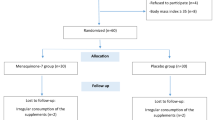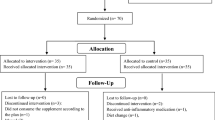Abstract
In diabetes mellitus, chronic hyperglycemia leads to formation of advanced glycation end products (AGEs). Binding of AGEs to receptors of AGE (RAGE) causes deleterious effects. In populations with a high consumption of n-3 long-chain polyunsaturated fatty acids, a lower prevalence of diabetes mellitus has been reported. We aimed to investigate the effects of n-3 fatty acid (EPA and DHA) supplementation on the levels of AGEs (carboxymethyl lysine (CML) and pentosidine), sRAGE, and nuclear factor kappa B (NF-kB) in type 2 diabetes mellitus (T2DM). T2DM patients (n = 38) treated with oral hypoglycemic agents, without insulin were supplemented with n-3 fatty acids (1.2 g/day) for 2 months. Plasma CML, pentosidine, sRAGE, and NF-kB levels were measured by ELISA both before and after the supplementation. n-3 fatty acid supplementation significantly reduced fasting glucose (p < 0.01), glycated hemoglobin (HbA1c) (p < 0.05), and pentosidine (p < 0.05) levels. The supplementation induced percentage changes in pentosidine and HbA1c and in pentosidine and creatinine were observed to be correlated (r = 0.349, p < 0.05) and (r = 0.377, p < 0.05), respectively. Waist circumference and systolic and diastolic pressures were significantly decreased due to n-3 supplementation (p < 0.001, p < 0.01, p < 0.01), respectively. Our results show that supplementation with n-3 fatty acid has beneficial effects on waist circumference; systolic and diastolic blood pressures; and the levels of glucose, HbA1c, and pentosidine in T2DM patients. However, the supplementation failed to decrease these parameters to the reference ranges for healthy subjects. In addition, the supplementation did not appear to induce any significant differences in CML, sRAGE, or NF-kB.


Similar content being viewed by others
References
American Diabetes Association, Bantle JP, Wylie-Rosett J, Albright AL, Apovian CM, Clark NG, Franz MJ, Hoogwerf BJ, Lichtenstein AH, Mayer-Davis E, Mooradian AD, Wheeler ML (2008) Nutrition recommendations and interventions for diabetes: a position statement of the American Diabetes Association. Diabetes Care 31(Suppl 1):S61–78
Basta G, Berti S, Cocci F, Lazzerini G, Parri S, Papa A, Battaglia D, Lubrano V, Del Turco S, Ravani M, Rizza A, De Caterina R, Marraccini P, Mazzone A (2008) Plasma N-epsilon-(carboxymethyl) lysine levels are associated with the extent of vessel injury after coronary arterial stenting. Coron Artery Dis 19(5):299–305
Basta G, Schmidt AM, De Caterina R (2004) Advanced glycation end products and vascular inflammation: implications for accelerated atherosclerosis in diabetes. Cardiovasc Res 63:582–592
Bender N, Portmann M, Heg Z, Hofmann K, Zwahlen M, Egger M (2014) Fish or n3-PUFA intake and body composition: a systematic review and meta-analysis. Obes Rev 15(8):657–665
De Caterina R, Madonna R, Bertolotto A, Schmidt EB (2007) n-3 fatty acids in the treatment of diabetic patients: biological rationale and clinical data. Diabetes Care 30(4):1012–1026
Field CJ, Ryan EA, Thomson AB, Clandinin MT (1990) Diet fat composition alters membrane phospholipid composition, insulin binding, and glucose metabolism in adipocytes from control and diabetic animals. J Biol Chem 265:11143–11150
Friedberg CE, Janssen MJ, Heine RJ, Grobbee DE (1998) Fish oil and glycemic control in diabetes: a meta-analysis. Diabetes Care 21:494–500
Friedl KE (2009) Waist circumference threshold values for type 2 diabetes risk. J Diabetes Sci Technol 3(4):761–769
Fu MX, Requena JR, Jenkins AJ, Lyons TJ, Baynes JW, Thorpe SR (1996) The advanced glycation end product, N epsilon-(carboxymethyl) lysine, is a product of both lipid peroxidation and glycoxidation reactions. J Biol Chem 271:9982–9986
Glauber H, Wallace P, Griver K, Brechtel G (1988) Adverse metabolic effect of omega-3 fatty acids in non-insulin-dependent diabetes mellitus. Ann Intern Med 108:663–668
Goova MT, Li J, Kislinger T, Qu W, Lu Y, Bucciarelli LG, Nowygrod S, Wolf BM, Caliste X, Yan SF, Stern DM, Schmidt AM (2001) Blockade of receptor for advanced glycation end-products restores effective wound healing in diabetic mice. Am J Pathol 159(2):513–525
Grandhee SK, Monnier VM (1991) Mechanism of formation of the Maillard protein cross-link pentosidine. Glucose, fructose, and ascorbate as pentosidine precursors. J Biol Chem 266:11649–11653
Gruppo Italiano per lo Studio della Sopravvivenza nell’Infarto miocardico (1999) Dietary supplementation with n-3 polyunsaturated fatty acids and vitamin E after myocardial infarction: results of the GISSI-Prevenzione trial. Lancet 354(9177):447–455
Haluzik MM, Haluzik M (2006) PPAR-alpha and insulin sensitivity. Physiol Res 55:115–122
Harris WS (1999) n-3 fatty acids and human lipoprotein metabolism: an update. Lipids 34(Suppl:S):257–258
Hudson BI, Carter AM, Harja E, Kalea AZ, Arriero M, Yang H, Grant PJ, Schmidt AM (2008) Identification, classification, and expression of RAGE gene splice variants. FASEB J 22(5):1572–1580
Katakami N, Matsuhisa M, Kaneto H, Matsuoka TA, Yasuda T, Sakamoto K, Yamasaki Y (2008) Endogenous secretory RAGE but not soluble RAGE is associated with carotid atherosclerosis in type 1 diabetes patients. Diab Vasc Dis Res 5:190–197
Kopecky J, Rossmeisl M, Flachs P, Kuda O, Brauner P, Jilkova Z, Stankova B, Tvrzicka E, Bryhn M (2009) n-3 PUFA: bioavailability and modulation of adipose tissue function. Proc Nutr Soc 68(4):361–369
Koyama H, Shoji T, Yokoyama H, Motoyama K, Mori K, Fukumoto S, Emoto M, Shoji T, Tamei H, Matsuki H, Sakurai S, Yamamoto Y, Yonekura H, Watanabe T, Yamamoto H, Nishizawa Y (2005) Plasma level of endogenous secretory RAGE is associated with components of the metabolic syndrome and atherosclerosis. Arterioscler Thromb Vasc Biol 25:2587–2593
Koyama H, Tanaka S, Monden M, Shoji T, Morioka T, Fukumoto S, Mori K, Emoto M, Shoji T, Fukui M, Fujii H, Nishizawa Y, Inaba M (2014) Comparison of effects of pioglitazone and glimepiride on plasma soluble RAGE and RAGE expression in peripheral mononuclear cells in type 2 diabetes: randomized controlled trial (PioRAGE). Atherosclerosis 234(2):329–334
Luo J, Rizkalla SW, Vidal H, Oppert JM, Colas C, Boussairi A, Guerre-Millo M, Chapuis AS, Chevalier A, Durand G, Slama G (1998) Moderate intake of n-3 fatty acids for 2 months has no detrimental effect on glucose metabolism and could ameliorate the lipid profile in type 2 diabetic men: results of a controlled study. Diabetes Care 21:717–724
Marx N, Walcher D, Ivanova N, Ivanova N, Rautzenberg K, Jung A, Friedl R, Hombach V, de Caterina R, Basta G, Wautier MP, Wautiers JL (2004) Thiazolidinediones reduce endothelial expression of receptors for advanced glycation end products. Diabetes 53(10):2662–2668
Massaro M, Habib A, Lubrano L, Del Turco S, Lazzerini G, Bourcier T, Weksler BB, De Caterina R (2006) The omega-3 fatty acid docosahexaenoate attenuates endothelial cyclooxygenase-2 induction through both NADP(H) oxidase and PKCepsilon inhibition. Proc Natl Acad Sci U S A 103:15184–15189
Moosheer SM, Waldschütz W, Itariu BK, Brath H, Stulnig TM (2014) A protein-enriched low glycemic index diet with omega-3 polyunsaturated fatty acid supplementation exerts beneficial effects on metabolic control in type 2 diabetes. Prim Care Diabetes 8(4):308–314
Morgan WA, Raskin P, Rosenstock J (1995) A comparison of fish oil or corn oil supplements in hyperlipidemic subjects with NIDDM. Diabetes Care 18:83–86
Nettleton JA, Katz R (2005) n-3 long-chain polyunsaturated fatty acids in type 2 diabetes: a review. J Am Diet Assoc 105(3):428–440
Nin JW, Ferreira I, Schalkwijk CG, Prins MH, Chaturvedi N, Fuller JH, Stehouwer CD, EURODIAB Prospective Complications Study Group (2009) Levels of soluble receptor for AGE are cross-sectionally associated with cardiovascular disease in type 1 diabetes, and this association is partially mediated by endothelial and renal dysfunction and by low-grade inflammation: the EURODIAB Prospective Complications Study. Diabetologia 52:705–714
Park IH, Yeon SI, Youn JH, Choi JE, Sasaki N, Choi IH, Shin JS (2004) Expression of a novel secreted splice variant of the receptor for advanced glycation end products (RAGE) in human brain astrocytes and peripheral blood mononuclear cells. Mol Immunol 40(16):1203–1211
Reddy S, Bichler J, Wells-Knecht KJ, Thorpe SR, Baynes JW (1995) N-epsilon-(carboxymethyl) lysine is a dominant advanced glycation end product (AGE) antigen in tissue proteins. Biochemistry 34:10872–10878
Sato A, Kawano H, Notsu T, Ohta M, Nakakuki M, Mizuguchi K, Itoh M, Suganami T, Ogawa Y (2010) Antiobesity effect of eicosapentaenoic acid in high-fat/high-sucrose diet-induced obesity: importance of hepatic lipogenesis. Diabetes 59(10):2495–2504
Schleicher ED, Wagner E, Nerlich AG (1997) Increased accumulation of the glycoxidation product N-(epsilon)-(carboxymethyl)lysine in human tissues in diabetes and aging. J Clin Invest 99:457–468
Sirtori CR, Crepaldi G, Manzato E, Mancini M, Rivellese A, Paoletti R, Pazzucconi F, Pamparana F, Stragliotto E (1998) One year treatment with ethyl esters of n-3 fatty acids in patients with hypertriglyceridemia and glucose intolerance: reduced triglyceridemia, total cholesterol and increased HDL-C without glycemic alterations. Atherosclerosis 137:419–427
Stirban A, Nandrean S, Götting C, Stratmann B, Tschoepe D (2014) Effects of n-3 polyunsaturated fatty acids (PUFAs) on circulating adiponectin and leptin in subjects with type 2 diabetes mellitus. Horm Metab Res 46(7):490–492
Tan KC, Chow WS, Tso AW, Xu A, Tse HF, Hoo RL, Betteridge DJ, Lam KS (2007) Thiazolidinedione increases serum soluble receptor for advanced glycation end-products in type 2 diabetes. Diabetologia 50(9):1819–1825
Tan KC, Shiu SW, Chow WS, Leng L, Bucala R, Betteridge DJ (2006) Association between serum levels of soluble receptor for advanced glycation end products and circulating advanced glycation end products in type 2 diabetes. Diabetologia 49(11):2756–2762
Udupa A, Nahar P, Shah S, Kshirsagar M, Ghongane B (2013) A comparative study of effects of omega-3 fatty acids, alpha lipoic acid and vitamin e in type 2 diabetes mellitus. Ann Med Health Sci Res 3(3):442–446
Wang K, Zhou Z, Zhang M, Zhang M, Fan L, Forudi F, Zhou X, Qu W, Lincoff AM, Schmidt AM, Topol EJ, Penn MS (2006) Peroxisome proliferator-activated receptor gamma down-regulates receptor for advanced glycation end products and inhibits smooth muscle cell proliferation in a diabetic and nondiabetic rat carotid artery injury model. J Pharmacol Exp Ther 317(1):37–43
Yamagishi S, Imaizumi T (2007) Serum levels of soluble form of receptor for advanced glycation end products (sRAGE) may reflect tissue RAGE expression in diabetes. Arterioscler, Thromb, Vasc Biol 27(6):e32
Yonekura H, Yamamoto Y, Sakurai S, Petrova RG, Abedin MJ, Li H, Yasui K, Takeuchi M, Makita Z, Takasawa S, Okamoto H, Watanabe T, Yamamoto H (2003) Novel splice variants of the receptor for advanced glycation end-products expressed in human vascular endothelial cells and pericytes, and their putative roles in diabetes-induced vascular injury. Biochem J 370:1097–1109
Zambon A, Austin MA, Brown BG, Hokanson JE, Brunzell JD (1993) Effect of hepatic lipase on LDL in normal men and those with coronary artery disease. Arterioscler Thromb 13:147–153
Acknowledgments
This work was supported by the Research Found of the Istanbul University (Project No. 7124).
Author information
Authors and Affiliations
Corresponding author
Ethics declarations
Conflict of interest
The authors declare that they have no conflict of interest.
Rights and permissions
About this article
Cite this article
Kurt, A., Andican, G., Siva, Z.O. et al. The effects of n-3 long-chain polyunsaturated fatty acid supplementation on AGEs and sRAGE in type 2 diabetes mellitus. J Physiol Biochem 72, 679–687 (2016). https://doi.org/10.1007/s13105-016-0506-4
Received:
Accepted:
Published:
Issue Date:
DOI: https://doi.org/10.1007/s13105-016-0506-4




